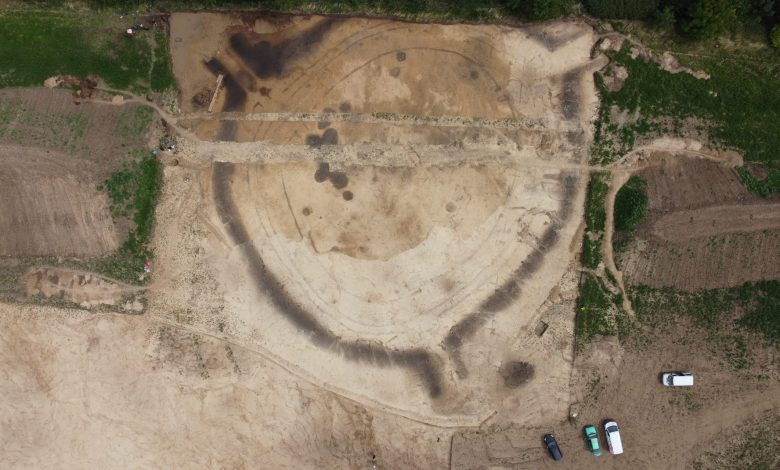Older than the pyramids of Egypt.. Archaeologists discover a 7,000-year-old circular building
Archaeologists excavating near Prague have discovered the remains of a Stone Age structure, older than Stonehenge and even the Egyptian pyramids, a mysterious complex known as the "roundel".
About 7,000 years ago, during the late Neolithic, or Neolithic, age, a local farming community may have gathered in this circular building, although its true purpose is unknown.
The drilled circular ring is large, with a diameter of about 55 meters, according to Radio Prague International.
And although it is "too early to say anything about the people who built this rotunda", it is clear that they were part of the Stroked Pottery culture, which flourished between 4900 BC and 4400 BC, according to Jaroslav Ridke, a spokesman for the Institute of Archeology of to the Czech Academy of Sciences (IAP) and an expert on circular structures for the Czech Republic, to Live Science in an email.
And Miroslav Krause, director of excavations in the Vino region on behalf of the Czech Academy of Sciences, revealed that the disclosure of the structure could give them an idea of the use of the building, according to "Russia Today".
Scientists first learned of the existence of the Vinoř roundabout in the 1980s, when construction workers were laying gas and water pipelines, according to Radio Prague International, but current excavations have revealed the entire structure for the first time.
So far, the team has recovered pottery fragments, animal bones and stone tools in the trench fill, according to Ridke.
Carbon-dated organic remains from this circular excavation could help the team establish the date the structure was built and possibly link it to a Neolithic settlement discovered nearby.
Ridke said the people who made Stroked pottery are known for building other "round" structures in the Bohemian region of the Czech Republic.
Their settled farming villages – at the intersection of modern Poland, East Germany and the northern Czech Republic – consisted of several longhouses, which were large rectangular structures, each accommodating 20 to 30 people.
Ridke noted, “The construction of round structures crossed the boundaries of many archaeological cultures. Various societies built the circular structures across Central Europe.”
"Roundness" was not an ancient feature until a few decades ago, when aerial photography and drones became an essential part of the archaeological toolkit.
But now, archaeologists know that “the rotunda is the oldest evidence of architecture in the whole of Europe,” Ridke told Radio International Prague earlier this year.
Viewed from above, "round" structures consist of one or more circular trenches with several gaps that act as entrances.
According to Radio Prague International, the interior of each "round" would likely have been lined with wooden poles, possibly with recesses plastered with mud. Hundreds of these circular earthworks have been found throughout Central Europe, but they all date back only two or three centuries.
While its popularity in the late Neolithic period is evident, its function remains in doubt.
According to Live Science, in 1991, the oldest known "rounder" was found in Germany, which also corresponds to the Stroked Pottery culture. Called the Goseck Circle, it is 75 meters in diameter, has a double wooden parapet and three entrances.
Because two of the inlets correspond to sunrise and sunset during the winter and summer solstice, one explanation for Goseck's circle is that it functions as an observatory or almanac of some sort, according to a 2012 study published in Archaeological Papers of the American Anthropological Association.
Ridke offered a more general explanation of the structure of Vinoř, noting that "the rotunda may have combined several functions, the most important of which were social ritual". It is possible that the "round" was built for gatherings of a large number of people, perhaps to commemorate events important to them as a society, such as astronomical phenomena or economic exchange.
Source:websites



